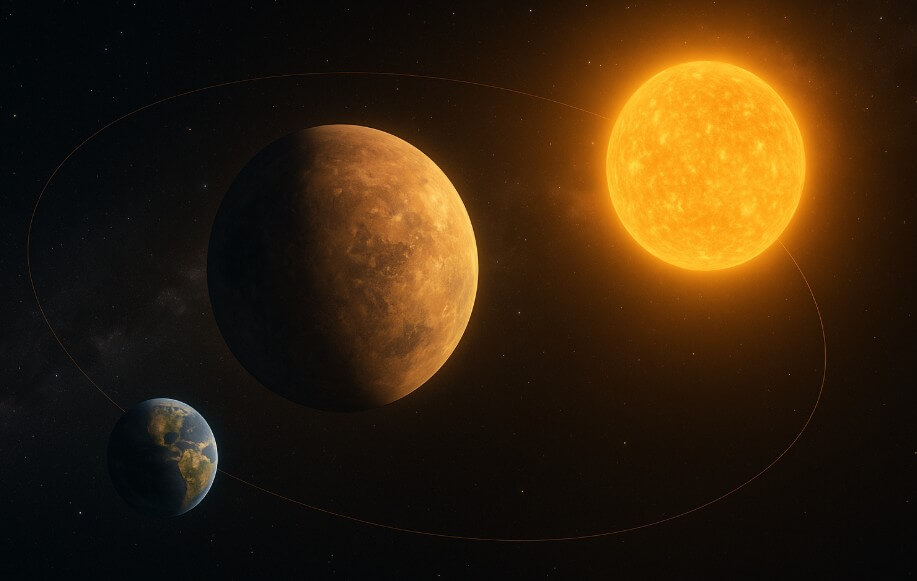Breakthrough Discovery: A Super-Earth in the Habitable Zone
An international team of astronomers, led by the Yunnan Astronomical Observatory of the Chinese Academy of Sciences, has announced the discovery of a remarkable exoplanet named Kepler-725c. This planet, about 10 times the mass of Earth, orbits a Sun-like star and sits within the so-called “habitable zone”—the region around a star where conditions might allow liquid water to exist. The finding, published in Nature Astronomy on June 3, 2024, marks a significant milestone in the ongoing search for worlds that could potentially support life.
Kepler-725c is located approximately 2,472 light-years from Earth and completes an orbit around its host star every 207.5 days. Its host, Kepler-725, is a G-type main sequence star, similar to our Sun but younger and more magnetically active. The planet receives about 1.4 times the solar radiation that Earth does, and its orbit brings it into the habitable zone for part of each year, raising intriguing questions about its climate and potential for habitability.
How Was Kepler-725c Discovered?
Most exoplanets are found using two main techniques: the transit method, which detects dips in a star’s brightness as a planet passes in front of it, and the radial velocity method, which measures the star’s slight wobble caused by the gravitational pull of orbiting planets. However, these methods are biased toward finding large planets on short orbits, making it difficult to spot Earth-like planets with longer, more distant orbits around Sun-like stars.
Kepler-725c was discovered using a more advanced approach called Transit Timing Variation (TTV). Instead of looking for the planet directly, astronomers observed subtle changes in the timing of another planet’s transits—specifically, Kepler-725b, a gas giant in the same system. The gravitational influence of Kepler-725c caused Kepler-725b’s transits to occur slightly earlier or later than expected. By carefully analyzing these timing variations, the team was able to infer the presence, mass, and orbit of the hidden super-Earth.
“It’s like observing how fast a clock runs to determine whether someone has quietly moved the hands,” explained Sun Leilei, lead author of the study.
This marks the first time the TTV technique has been used to discover a super-Earth in the habitable zone of a Sun-like star, demonstrating its power to reveal planets that traditional methods might miss.
What Makes Kepler-725c Special?
Super-Earths—planets larger than Earth but smaller than Neptune—are among the most common types of planets in our galaxy. However, most known super-Earths in habitable zones orbit red dwarf stars, which are smaller and cooler than our Sun. These stars make it easier to detect planets due to stronger transit and radial velocity signals. Finding a super-Earth in the habitable zone of a Sun-like star is much rarer and more significant for the search for life, as such stars are more similar to our own solar system.
Kepler-725c’s orbit is notably elliptical, meaning it spends only part of its year within the habitable zone. This could lead to dramatic climate variations, depending on the planet’s atmosphere and surface conditions. While its mass suggests it could be a rocky world, scientists caution that its true nature—whether rocky, water-rich, or gas-dominated—remains unknown without direct atmospheric observations.
Despite its promising location, Kepler-725c is extremely distant—about 160 million times farther from us than the Earth is from the Sun. This makes direct study challenging, and current telescopes like the James Webb Space Telescope cannot probe its atmosphere because the planet does not transit its star from our viewpoint.
Why Is the TTV Technique a Game Changer?
The TTV method opens new possibilities for exoplanet discovery, especially for planets that do not transit their stars or are too small and distant to be detected by other means. By monitoring the gravitational effects of unseen planets on their neighbors, astronomers can uncover hidden worlds in systems that would otherwise go undetected.
This technique is expected to play a major role in upcoming space missions, such as the European Space Agency’s PLATO mission and China’s Earth 2.0 project. These missions aim to find more Earth-like planets around Sun-like stars, and TTV could dramatically increase the number of potentially habitable worlds we can study.
“This discovery demonstrates the potential of the TTV technique to detect low-mass planets in habitable zones of Sun-like stars,” said Sun Leilei.
The international research team included scientists from China, Germany, and the UK, reflecting the global effort to answer one of humanity’s oldest questions: Are we alone in the universe?
What Are the Next Steps?
While the discovery of Kepler-725c is a major step forward, much remains unknown. Scientists hope that future telescopes and missions will allow them to directly observe the atmospheres of such planets, searching for signs of water, oxygen, or other indicators of life. For now, Kepler-725c stands as a tantalizing clue in the cosmic search for another Earth.
As technology advances and new detection methods like TTV become more widespread, the chances of finding truly Earth-like planets—and perhaps even life—continue to grow.
In Summary
- Kepler-725c is a super-Earth about 10 times the mass of Earth, orbiting a Sun-like star in the habitable zone.
- The planet was discovered using the Transit Timing Variation (TTV) technique, which detects hidden planets by their gravitational effects on neighboring planets.
- This is the first time TTV has revealed a super-Earth in the habitable zone of a Sun-like star, marking a breakthrough in exoplanet discovery.
- Kepler-725c’s orbit brings it into the habitable zone for part of its year, raising questions about its climate and potential for life.
- The discovery highlights the growing power of international collaboration and new detection methods in the search for Earth-like worlds beyond our solar system.












